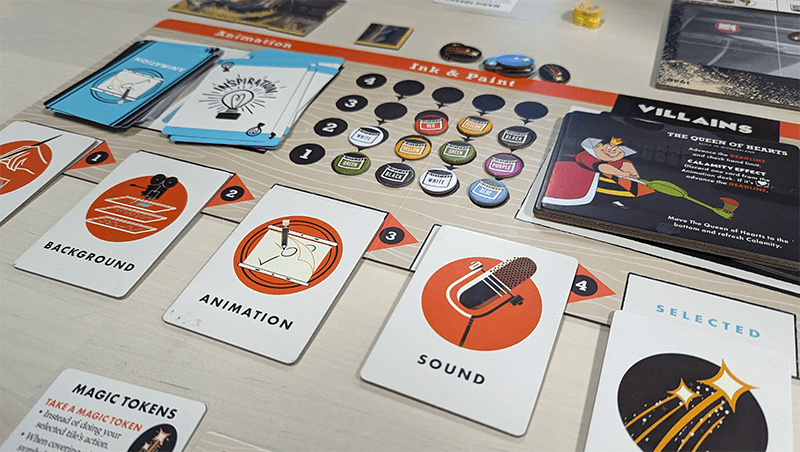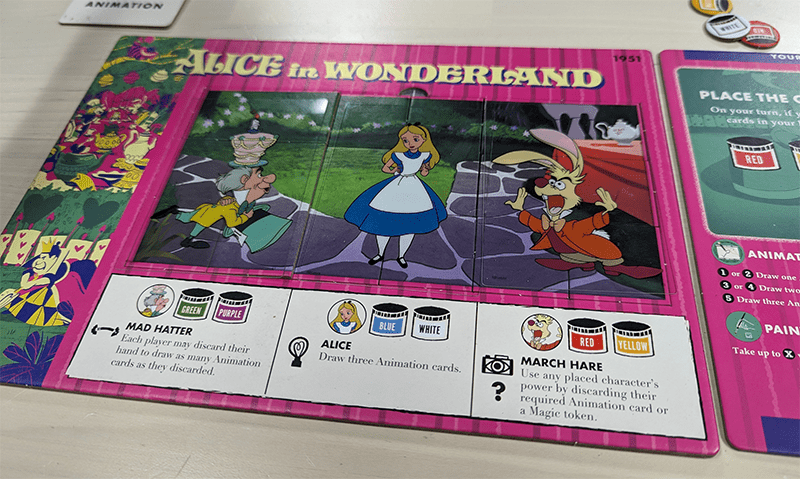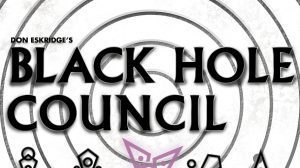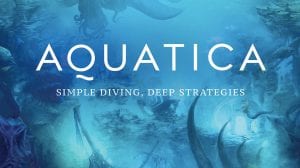Disclosure: Meeple Mountain received a free copy of this product in exchange for an honest, unbiased review. This review is not intended to be an endorsement.
Tapping into nostalgia has become an influential weapon in the hands of intellectual property owners. The film industry reimagines beloved 80s classics for the “modern” audience, indie comic creators harness the essence of the 90s, and video game developers abuse the pixel-art aesthetic to entice older players like myself. In this realm, Walt Disney has long been an adept player, and Funko Games exhibits a deep understanding of Disney’s approach.
Because of this belief, it came as no shock to witness Funko Games venture into the realm of the golden era of Walt Disney. Their familiarity with the retro aesthetic is evident, having already crafted games such as Rear Window and Pan Am that exude a similar allure.
What took me by surprise was a cooperative game that pays homage to the animation efforts behind timeless films. Disney Animated not only celebrates these cherished classics but also highlights the collaborative spirit inherent in any creative endeavor.
That’s where you and your friends come in. All of you are animators at Disney and must complete your films before the deadline hits. The villains of these films aren’t too pleased with this idea, as they know how these movies end and will do their best to spoil your attempts to finish them. You will engage in discussions with other animators to prioritize various aspects of the production process, including backgrounds, ink, paint, animation, sound, and, of course, the enchanting touch of Disney’s Magic.

Starting The Steamboat
All of these discussions sprout from the action tiles residing on the studio board, lined up in a row from 1 to 5. At the start of your turn, you will pick one of these actions and execute it. The higher the number, the stronger the action. After completing the action, you will slide the tile down to 1 and push the rest of the tiles forward. Now, I’m sure players of Civilization: A New Dawn and Ark Nova will think this sounds familiar, and that’s because it is. However, this is the first time we’ve seen this action selection system used in a cooperative game.
Most actions in the game will produce valuable resources. Animation actions will reward you with animation cards that can be used for calamity cards or to activate character powers in your film. Ink & Paint actions allow you to acquire paint from the studio, which can be used for calamity cards or to insert your characters in your film. However, in order to place your characters, you must first complete the background using tiles and the Background action.
The Sound action is a bit more complex to describe, as it varies for each film. For example, in the case of 101 Dalmatians, it involves giving dog bones to other players, which can be used as wild paint or magic tokens. On the other hand, the Magic action is one of the most powerful actions available, as it acts as a wildcard action while requiring you to spend a Magic token.
They Aren’t Bad. They Are Just Drawn That Way.
After you and your friends complete their turns, it’s time for the current Villain to get a go at it. For each calamity card that remains, you must execute the corresponding calamity effect of the Villain. If you fail to meet the conditions of a calamity effect, the turn marker advances one step closer to the deadline. Once the Villain finishes their turn, a new round begins, featuring a fresh set of calamity cards and a new Villain.
Calamity cards are the beating heart of Disney Animated’s difficulty and have an explicit cost to get rid of them. Some will require specific colors of paint, particular animation card types, or a weaker action number. There are some you cannot remove, forcing you to deal with the calamity effect of the current Villain. The difference between the easier and harder difficulties is the number of calamity cards per round, nothing else.
As for your end goal, it’s straightforward. You need to fill out the background with your tiles, put all three of your film’s characters on the backgrounds, and then capture the villain under peculiar conditions. All players must complete their films, and if the deadline is missed, you lose. Simple as that.
What I describe might seem like a painless game, but the rulebook betrays these impressions. It’s been a while since I’ve read a rulebook with a layout that looks like a deranged puzzle to the eyes. Brevity is the soul of wit, as William Shakespeare wrote, and I can hear his ghost howling as I decipher these wordy paragraphs to explain simple game concepts.
Unfortunately, I have quite a few other issues with Disney Animated. If anything, this is a good case study as to why scoring reviews is bad, and I’m glad I don’t have to do it. This cardboard box with Disney’s logo plastered all over it is, for me, a physical manifestation of mixed feelings.

Hey Good Lookin’
I’ll start with the easiest, which everyone noticed when they saw the photos for this game: The production. Disney Animated is dazzling. It’s one of the most photogenic games out there, and it could easily have its own Patreon page as a side hustle, or that other site that ends with the word fans.
Thanks to its captivating presentation, Disney Animated stands out as one of the most straightforward games I’ve had the opportunity to review. As per my review guidelines, I typically require a minimum of five play sessions before writing the first sentence. Surprisingly, I was able to meet this requirement within a single weekend without much resistance from my fellow guinea pig players. That alone is quite telling of the glamor and glitz of Disney Animated’s table presence.
Okay, so the game looks nice, the rulebook is word barf, and the game flow is sensible, so what’s the catch? Why am I not loving this game? Compared to other cooperative games, Disney Animated is linear and repetitive, like a doorless hallway.
The first clue that hinted at this was the action selection system. Since every action resets to the 1 slot after being used, it forces the players to cycle through different types of actions to keep those tiles moving while having productive turns. A significant portion of the conversations will revolve around this aspect, ensuring that everyone is making steady progress with their films. There are some Sound abilities or character powers that can change this up; otherwise, the game is essentially centered around this cycle of prioritization and optimization.
Even finishing the films themselves doesn’t deviate from game to game. You must fill out the background, you need paint for your characters after the background is completed, and you need to complete your end game condition, which is related to your Sound effect. It must be done in this exact order. I do appreciate the intention behind this design, which aims to replicate the stringent animation process of the golden era, but accuracy doesn’t always lead to an engaging game.
The villains don’t significantly alter the overall formula either. While they possess their own calamities, their presence doesn’t establish substantial changes. Similarly, the calamity cards themselves don’t deviate significantly, as their mechanisms mainly involve discarding animation cards and colors of various types. The villains could have easily been replaced by the IRS and no one would notice, as they both serve the same purpose of draining resources without accountability.
A Great Opening Weekend
I had an easy time getting at least five play sessions in a weekend, not because of the pretty presentation but rather because of the game itself. People enjoyed it, wanted to play again, and tried to beat it. That’s not something I can say about most games I bring out for review. Whatever Disney Animated was serving, the people were gobbling it up.
This brings me to an interesting crossroads. Having been a part of the tabletop gaming hobby since the early 2000s and starting to write reviews a few years ago, I find myself compelled to draw comparisons to an ocean full of gameplay experiences. Prior to writing reviews, I disliked cooperative games and actively avoided them as if they were covered in a blue tarp.
However, suddenly I find myself not only writing reviews but also reviewing some of the most challenging cooperative games out there. Games like Testament and Tokyo Sidekick, which are mentioned in whispered tones among enthusiasts of the cooperative genre. Now that I think about it, I had more character development than a modern-day Star Wars character.
It’s for this reason that I can’t exclusively use my own experiences to judge this game because I’m abnormal in this situation. Board gaming is a social hobby, and it would be narcissistic of me to ignore the experiences of the other people sitting at the table. They were enjoying Disney Animated quite a lot, and I can see why.

Rolling The Credits
Like any other reputable cooperative game, Disney Animated evokes dialog among your peers. The restriction of the action selection system presents a challenge that requires strategizing through discussions. The allocation of magic tokens, utilization of sound abilities, and leveraging of character powers will dynamically shift during gameplay. Deciding which calamity cards to address or disregard will ignite heated debates.
To my astonishment, Disney Animated presents a demanding puzzle of optimization that doesn’t have any issues kicking you and your friends out to the front porch if you make dumb mistakes. It’s not an easy game and I think anyone new to cooperative games wouldn’t go wrong with this one if they are looking for a meticulously executed challenge within a digestible format.
Nevertheless, I also can’t help but point out that Disney Animated will feel sterile for those of us who have been sitting in the rays of cooperative gaming for quite some time. It walks down the path of least resistance, yet it manages to strut a stride that will turn heads. Not every game needs to be groundbreaking, and Disney Animated deliberately avoids taking such a gamble. In this aspect, Disney Animated embodies the essence of modern-day Disney: meticulously designed to appeal to a broad audience, ensuring widespread enjoyment without straying too far from the familiar and comfortable territory.











